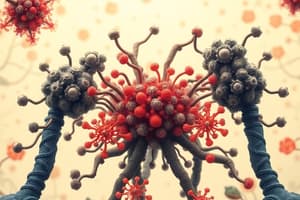Podcast
Questions and Answers
What is the function of the lock-and-key hypothesis in pharmacodynamics?
What is the function of the lock-and-key hypothesis in pharmacodynamics?
- To show the effects of substrate binding to the allosteric site
- To explain the concept of Efficacy vs Potency among agonists
- To describe how a substrate fits into the active site of a protein (correct)
- To illustrate the competitive vs non-competitive inhibitions
What encodes the 20 different amino acids in the human body?
What encodes the 20 different amino acids in the human body?
- Polypeptides
- Codons (correct)
- DNA/mRNA chain
- Nucleotides
What is the primary role of proteins in pharmacodynamics?
What is the primary role of proteins in pharmacodynamics?
- To regulate receptor activity levels
- To exhibit competitive inhibitions
- To affect substrate-protein binding (correct)
- To encode amino acids through polypeptide chains
How do substrates bind to proteins at the allosteric site?
How do substrates bind to proteins at the allosteric site?
What do competitive vs non-competitive inhibitions refer to in pharmacodynamics?
What do competitive vs non-competitive inhibitions refer to in pharmacodynamics?
What is the main concept behind Efficacy vs Potency among agonists in pharmacodynamics?
What is the main concept behind Efficacy vs Potency among agonists in pharmacodynamics?
What is the main function of insulin?
What is the main function of insulin?
What happens to proteins when they denature at extreme pH or temperature?
What happens to proteins when they denature at extreme pH or temperature?
According to the lock-and-key hypothesis, what is required for a protein to exhibit its activity?
According to the lock-and-key hypothesis, what is required for a protein to exhibit its activity?
What is the effect of a substrate binding to the active site termed as?
What is the effect of a substrate binding to the active site termed as?
What type of receptor proteins are located on the cell membrane?
What type of receptor proteins are located on the cell membrane?
What does molecular polarity affect in substrate-protein affinity?
What does molecular polarity affect in substrate-protein affinity?
Which type of substrate binds to the active site and competes for the same site?
Which type of substrate binds to the active site and competes for the same site?
What is the main effect of substrates that bind to the active site and compete for the same site?
What is the main effect of substrates that bind to the active site and compete for the same site?
What classifies substrates that bind to the active site and compete for the same site?
What classifies substrates that bind to the active site and compete for the same site?
What is the main function of hemoglobin?
What is the main function of hemoglobin?
What is the relationship between nucleotides and codons in DNA/mRNA?
What is the relationship between nucleotides and codons in DNA/mRNA?
How many different amino acids do the 64 codons in our DNA/mRNA chain encode?
How many different amino acids do the 64 codons in our DNA/mRNA chain encode?
What do many amino acids link together in a line to form?
What do many amino acids link together in a line to form?
What do polypeptides link and entwine together to form?
What do polypeptides link and entwine together to form?
What is the function of the lock-and-key hypothesis in pharmacodynamics?
What is the function of the lock-and-key hypothesis in pharmacodynamics?
What is the term for the concept of Efficacy vs Potency among antagonists in pharmacodynamics?
What is the term for the concept of Efficacy vs Potency among antagonists in pharmacodynamics?
What is the main concept behind the lock-and-key hypothesis in relation to proteins?
What is the main concept behind the lock-and-key hypothesis in relation to proteins?
What is the effect of substrates that bind to the active site and compete for the same site?
What is the effect of substrates that bind to the active site and compete for the same site?
What happens when proteins denature at extreme pH or temperature?
What happens when proteins denature at extreme pH or temperature?
What encodes the 20 different amino acids in the human body?
What encodes the 20 different amino acids in the human body?
What classifies substrates that bind to the active site and compete for the same site?
What classifies substrates that bind to the active site and compete for the same site?
What is the primary role of proteins in pharmacodynamics?
What is the primary role of proteins in pharmacodynamics?
According to the text, what is required for a protein to exhibit its activity?
According to the text, what is required for a protein to exhibit its activity?
What type of receptor proteins are located on the cell membrane?
What type of receptor proteins are located on the cell membrane?




